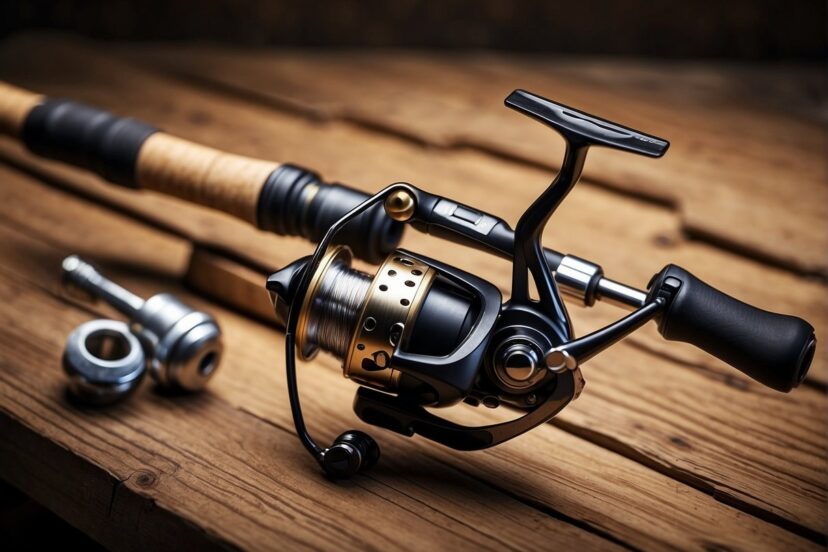Fishing Rod Parts: A Comprehensive Guide
*We may earn a commission for purchases made using our links. Please see our disclosure to learn more.
Fishing Rod Parts: Understanding the Components That Enhance Your Angling Experience
Understanding the various parts of a fishing rod is essential for both novice and experienced anglers. I use a fishing rod, a complex tool crafted for casting bait or lures, hooking and battling fish, and bringing them to me. It comprises numerous components, each serving a distinct function and purpose. The main parts include the rod blank, guides, reel seat, and handle.
The rod blank is the backbone of the fishing rod, typically made of graphite, fiberglass, or a composite of both. It dictates the overall strength and flexibility of the rod. Along the length of the blank, you’ll find guides which are circular loops that help in directing the fishing line from the reel to the tip of the rod. I use the reel seat to mount my fishing reel securely, ensuring it stays firmly in place while I fish.
Lastly, the handle of the rod, usually made of cork or EVA foam, provides grip for the angler. It’s designed to be comfortable to hold for long periods and in various weather conditions. Each of these parts can significantly affect the performance of the rod and, consequently, the fishing experience. Understanding their functions can greatly enhance the success and enjoyment of an angler’s fishing trip.
Essentials of Rod Building

Building a fishing rod requires attention to detail and an understanding of the components that will bring your custom creation to life. Let’s explore the important aspects of choosing the right rod blank and selecting quality components for a durable and efficient fishing rod.
Choosing the Right Rod Blank
When I select a rod blank, it’s crucial to consider the material and action that suit my fishing needs. Rod blanks are commonly made from fiberglass, graphite, or composite materials. I prefer graphite for its sensitivity and strength, particularly for freshwater fishing where detecting light bites is key.
- Fiberglass:
- Pros: Durable, Heavy-duty
- Cons: Heavier, Less sensitive
- Graphite:
- Pros: Lightweight, Sensitive
- Cons: More brittle, Expensive
- Composite:
- Pros: Balance of flexibility and strength
- Cons: May not excel in all aspects compared to specialized blanks
I also pay close attention to the power and action ratings, which determine how much the rod bends under stress and where the bend initiates. American Tackle and Mud Hole are two of my go-to suppliers for quality rod blanks due to their wide range of options and reliable performance.
Selecting Quality Components of Fishing Rod Parts
After choosing the blank, sourcing the highest quality components is the next step. From guides and reel seats to handles and ferrules, each piece plays a significant role in the rod’s function. Fuji is a brand that I trust for guides and reel seats, known for their durability and craftsmanship.
- Guides:
- Function: Direct the fishing line along the rod
- Material: Stainless steel, titanium, or ceramic
- Consideration: Number, spacing, and size influence casting accuracy and distance
- Reel Seats:
- Function: Secure the reel to the rod
- Material: Graphite, aluminum, or plastic composites
- Consideration: Must match the rod’s intended use and ensure a comfortable grip
- Handle Components:
- Function: Provide grip and weight distribution
- Material: Cork or EVA foam
- Consideration: Should be ergonomic and suited to the fishing conditions
Using the right tools and accessories is crucial for assembling these components. The quality of my build significantly depends on the precision of my equipment, like epoxy mixers, guide wrapping tools, and drying motors. Investing in reliable tools not only facilitates a smoother build process but also ensures the longevity and performance of the finished fishing rods.
Fishing Rod Parts: Rod Components and Functions

In this section, I examine the essential parts that make up a fishing rod, focusing on their specific functions which are critical for a seamless angling experience.
Handles and Grips
Handles are the primary point of contact I use to control my fishing rod. Constructed mainly from materials like cork, EVA foam, or even Winn grips, they’re designed for comfortable holding during prolonged periods of use. The grips are part of the handle, crafted to provide a non-slip surface for better rod control, especially in wet conditions.
Reel Seats and Their Installation
The reel seat is where I mount my fishing reel onto the rod. It’s a sturdy component, usually made from graphite or aluminum, to ensure stability and durability. Installation of the reel seats involves securing them onto the rod blank, making sure they align correctly to maintain the balance and function of the rod.
Guides and Line Flow
Having a smooth line flow is vital for casting and reeling in the catch effectively. Guides are the circular loops attached along the rod’s length, typically made from stainless steel or ceramics. They work to uniformly distribute the stress along the rod and minimize friction. The number and size of the guides directly influence the performance of my casts and the overall sensitivity of the rod.
The Importance of Tip Tops
At the very end of my rod sits the tip top, which is the final guide where the line exits the rod. It’s a crucial component as it influences casting distance, accuracy, and the sensitivity of the rod to fish bites. I make sure the tip top is firmly attached and aligned with the other guides for the best performance. It typically has a metal frame and a ceramic or stainless steel ring for reinforcement.
Fishing Rod Parts: The Assembly Process
In the meticulous task of assembling a fishing rod, I find that precision and attention to detail play crucial roles. Here, I’ll outline the key steps and considerations in this process.

Preparing and Aligning Components
Before I start assembling my fishing rod, I make sure all components are laid out properly and ready to assemble. I check the fishing rod blank for imperfections and ensure the ferrules are aligned. This preparatory step helps avoid any issues during the assembly.
- Tools Required: Tape measure, Rod dryer, Calipers.
Securing the Reel Seat and Handles
Next, I affix the reel seat to the rod blank, making sure it’s positioned correctly for optimal balance and comfort. Following this, I slide the handles – typically made from cork or EVA foam – onto the rod, and secure them using waterproof epoxy.
- Supplies: Epoxy glue, Handle material (cork/EVA).
- Key Point: Ensure no gaps exist between the rod blank and the reel seat.
Attaching Guides and Ferrules
I carefully space the guides evenly along the blank because proper placement is crucial for distributing tension evenly when I cast the line. The ferrules, if the rod has multiple segments, must fit snugly to maintain the rod’s integrity.
- Steps:
- Measure correct distances for guide placement.
- Affix ferrules with precise alignment.
Applying Thread Windings
To finalize the assembly, I wrap thread windings around the base of each guide to hold them in place. The thread must be tight and even with no overlaps.
- Tools Needed: Thread, Bobbin, and Thread Burnisher.
- Watch Out: Uneven windings can cause line friction and wear.
Throughout the assembly, I use building kits and specific tools designed for fishing rod construction to ensure quality and durability, especially when the rod stands against the pulling force of fish and the resistance of the water.
Finishing Touches for Fishing Rod Parts

I understand that the final touches in rod building are critical for both aesthetics and durability. In this section, I’ll cover how to apply the final coatings, install the butt cap, and explore customization options to ensure both the high quality and personal touch of the fishing rod.
Applying the Final Coatings
When I apply final coatings, I ensure they are evenly distributed to protect the rod and secure its components. I typically use a high-quality epoxy for a strong finish. It’s important to allow each coat to cure fully before adding the next one, to prevent any tackiness or imperfections.
Installing the Butt Cap
The butt cap installation is a step that should not be rushed. I make sure to select a cap that enhances grip and balances the rod. When I check for an aluminum trim ring for the butt cap, I make sure it’s the right size. I search for suppliers with free shipping, though there may be exclusions, and prices and availability can differ.
Customization Options
Customization is where I can get creative. From choosing trim parts to adding personalized decals, these options reflect the angler’s style while maintaining the rod’s functionality. Customizations might include:
- Trim Rings: They can be anodized aluminum or graphite for different reel seats, and I can pick from a variety of colors.
- Decals: Adding a personal or brand decal can make the rod distinctive.
- Nail Polish: For quick touch-ups, especially when time-bound, black nail polish can be useful on guides for a temporary fix.
Pro Tip: Opt for rod building supplies that allow for both visual appeal and functional integrity. Some suppliers offer vast selections of such supplies online, and I always take advantage of that.
FAQs About Fishing Rod Parts

1. What components make up a spinning rod?
A spinning rod typically consists of a blank, handle, reel seat, and guides. The blank is the main part of the rod, and it’s usually made from materials like graphite or fiberglass. The handle provides grip and the reel seat is where you attach your reel. Guides are rings that line the rod’s length, guiding the fishing line from the reel to the rod tip.
2. How do you identify the different sections of a baitcasting rod?
I recognize a baitcasting rod by its trigger-style grip, the reel seat placed on the top side of my rod, and a set of guides that decrease in size towards my rod tip. The rod blank divides into sections: the tip section, which is more flexible, and the butt section, which is thicker and more robust.
3. What terminology is used for the elements of a fly fishing rod?
In fly fishing rods, terminology includes the tip-top, which is the final guide at the rod’s end. The ferrules are the connections between sections of a multi-piece rod. The rod’s length is divided into sections sometimes referred to as the tip, mid, and butt section. The grip is where you hold the rod and cast the line, and the reel seat secures the reel to the rod.
4. What are the purposes of the various guides on a fishing rod?
I choose guides for my fishing rod that are designed to maintain control and reduce friction as I cast out and reel in the line. Starting with the stripping guide near the reel, the line passes through successively smaller guides, culminating in the tip-top, to facilitate smooth movement and improve casting accuracy and distance.
5. What should be considered when selecting materials for rod building?
When selecting materials for rod building, consider the type of fishing and the characteristics you desire in a rod. Graphite offers sensitivity and lightweight properties, while fiberglass is known for durability and flex. Composite materials can provide a balance between the two.




